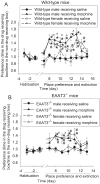Glutamate transporter type 3 participates in maintaining morphine-induced conditioned place preference
- PMID: 28049029
- PMCID: PMC5303644
- DOI: 10.1016/j.neuroscience.2016.12.038
Glutamate transporter type 3 participates in maintaining morphine-induced conditioned place preference
Abstract
Glutamate transporters (EAAT) have been implicated in the drug addiction behavior. We determined whether EAAT type 3 (EAAT3) played a role in morphine addiction. Six- to eight-week-old EAAT3 knockout (EAAT3-/-) mice and their wild-type littermates received 3 intraperitoneal injections of 10mg/kg morphine, each on an alternative day, to induce conditioned place preference (CPP). Two days after the place preference returned to baseline, mice received 2.5mg/kg morphine to induce reinstatement. Some mice received intraperitoneal injection of 4mg/kg riluzole, an EAAT activator, 30min before morphine or saline injection. Hippocampus, medial prefrontal cortex, nucleus accumbens and ventral tegmental area were harvested for Western analysis 24h after the last dose of morphine was injected. Morphine induced CPP in wild-type and EAAT3-/- mice. Gender is not a statistically significant factor to influence this behavior. This conditioned behavior extinguished after morphine administration was stopped for 8-9days in wild-type mice, while this extinction occurred 6days after discontinuation of morphine injection in EAAT3-/- mice. A small dose of morphine similarly reinstated the conditioned behavior in the wild-type and EAAT3-/- mice. Riluzole abolished morphine-induced CPP during the initial place preference. Morphine increased EAAT3 expression in the plasma membrane of medial prefrontal cortex, nucleus accumbens and ventral tegmental area but did not affect EAAT3 expression in the hippocampus. These results suggest that EAAT3 delays the extinction of morphine-induced CPP. EAAT activation may prevent the formation of morphine-induced CPP.
Keywords: conditioned place preference; glutamate transporter; mice; morphine.
Copyright © 2016 IBRO. Published by Elsevier Ltd. All rights reserved.
Figures





Similar articles
-
Effects of the altered activity of δ-opioid receptor on the expression of glutamate transporter type 3 induced by chronic exposure to morphine.J Neurol Sci. 2013 Dec 15;335(1-2):174-81. doi: 10.1016/j.jns.2013.09.026. Epub 2013 Sep 25. J Neurol Sci. 2013. PMID: 24120272
-
AMN082-a metabotropic glutamate receptor type 7 allosteric agonist in the NAc facilitates extinction and inhibits the reinstatement of morphine-induced conditioned place preference in male rats.Brain Res Bull. 2018 Jun;140:28-33. doi: 10.1016/j.brainresbull.2018.03.017. Epub 2018 Mar 29. Brain Res Bull. 2018. PMID: 29605484
-
Cannabinoid 1 receptor blockade in the dorsal hippocampus prevents the reinstatement but not acquisition of morphine-induced conditioned place preference in rats.Neuroreport. 2017 Jul 5;28(10):565-570. doi: 10.1097/WNR.0000000000000796. Neuroreport. 2017. PMID: 28492416
-
Stress and opioids: role of opioids in modulating stress-related behavior and effect of stress on morphine conditioned place preference.Neurosci Biobehav Rev. 2015 Apr;51:138-50. doi: 10.1016/j.neubiorev.2014.12.018. Epub 2015 Jan 27. Neurosci Biobehav Rev. 2015. PMID: 25636946 Review.
-
The importance of the excitatory amino acid transporter 3 (EAAT3).Neurochem Int. 2016 Sep;98:4-18. doi: 10.1016/j.neuint.2016.05.007. Epub 2016 May 24. Neurochem Int. 2016. PMID: 27233497 Free PMC article. Review.
Cited by
-
Effects of ceftriaxone on hydrocodone seeking behavior and glial glutamate transporters in P rats.Behav Brain Res. 2018 Jul 16;347:368-376. doi: 10.1016/j.bbr.2018.03.043. Epub 2018 Mar 28. Behav Brain Res. 2018. PMID: 29604365 Free PMC article.
-
A Mini-Review of the Role of Glutamate Transporter in Drug Addiction.Front Neurol. 2019 Oct 22;10:1123. doi: 10.3389/fneur.2019.01123. eCollection 2019. Front Neurol. 2019. PMID: 31695674 Free PMC article. Review.
-
Glutamatergic Systems and Memory Mechanisms Underlying Opioid Addiction.Cold Spring Harb Perspect Med. 2021 Mar 1;11(3):a039602. doi: 10.1101/cshperspect.a039602. Cold Spring Harb Perspect Med. 2021. PMID: 32341068 Free PMC article. Review.
-
Glutamate Transport: A New Bench to Bedside Mechanism for Treating Drug Abuse.Int J Neuropsychopharmacol. 2017 Oct 1;20(10):797-812. doi: 10.1093/ijnp/pyx050. Int J Neuropsychopharmacol. 2017. PMID: 28605494 Free PMC article. Review.
References
-
- Aoyama K, Suh SW, Hamby AM, Liu J, Chan WY, Chen Y, Swanson RA. Neuronal glutathione deficiency and age-dependent neurodegeneration in the EAAC1 deficient mouse. Nat Neurosci. 2006;9:119–126. - PubMed
-
- Cao MN, Zhou YB, Gao AH, Cao JY, Gao LX, Sheng L, Xu L, Su MB, Cao XC, Han MM, Wang MK, Li J. Curcusone D, a novel ubiquitin-proteasome pathway inhibitor via ROS-induced DUB inhibition, is synergistic with bortezomib against multiple myeloma cell growth. Biochim Biophys Acta. 2014;1840:2004–2013. - PubMed
-
- Cheah BC, Vucic S, Krishnan AV, Kiernan MC. Riluzole, neuroprotection and amyotrophic lateral sclerosis. Curr Med Chem. 2010;17:1942–1199. - PubMed
-
- Daglish MR, Weinstein A, Malizia AL, Wilson S, Melichar JK, Britten S, Brewer C, Lingford-Hughes A, Myles JS, Grasby P, Nutt DJ. Changes in regional cerebral blood flow elicited by craving memories in abstinent opiate-dependent subjects. Am J Psychiatry. 2001;158:1680–1686. - PubMed
MeSH terms
Substances
Grants and funding
LinkOut - more resources
Full Text Sources
Other Literature Sources
Molecular Biology Databases

